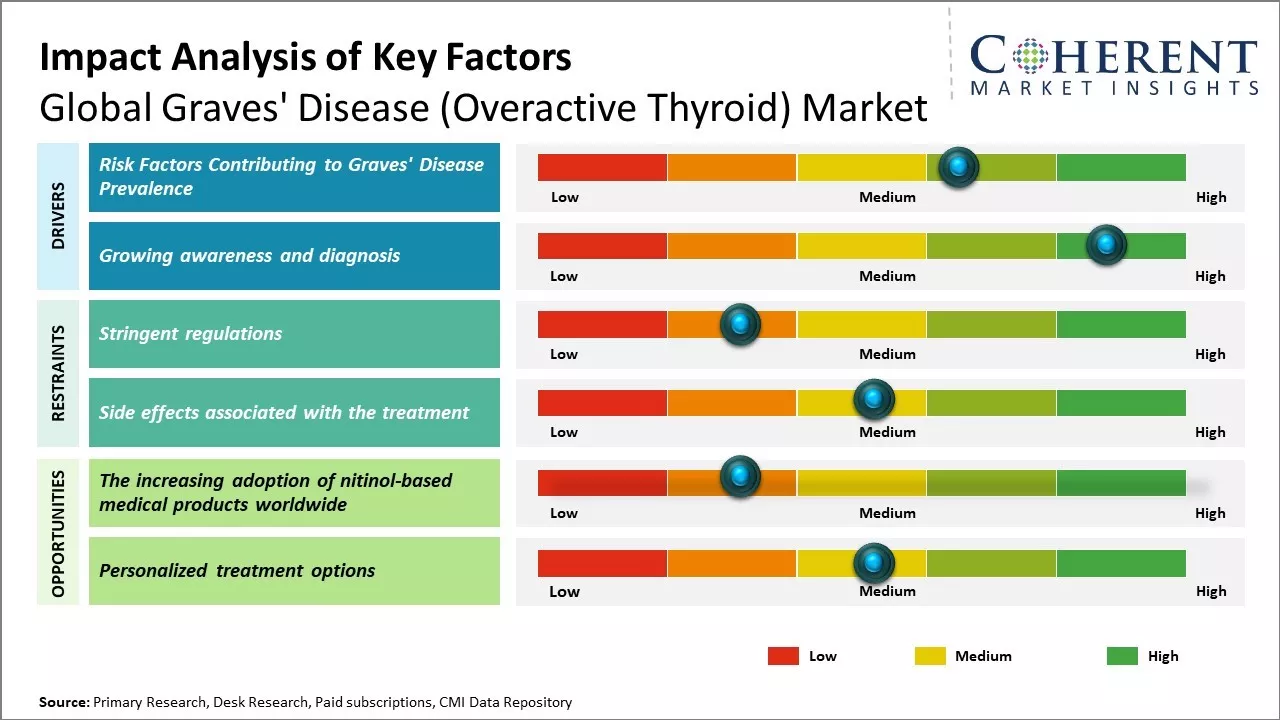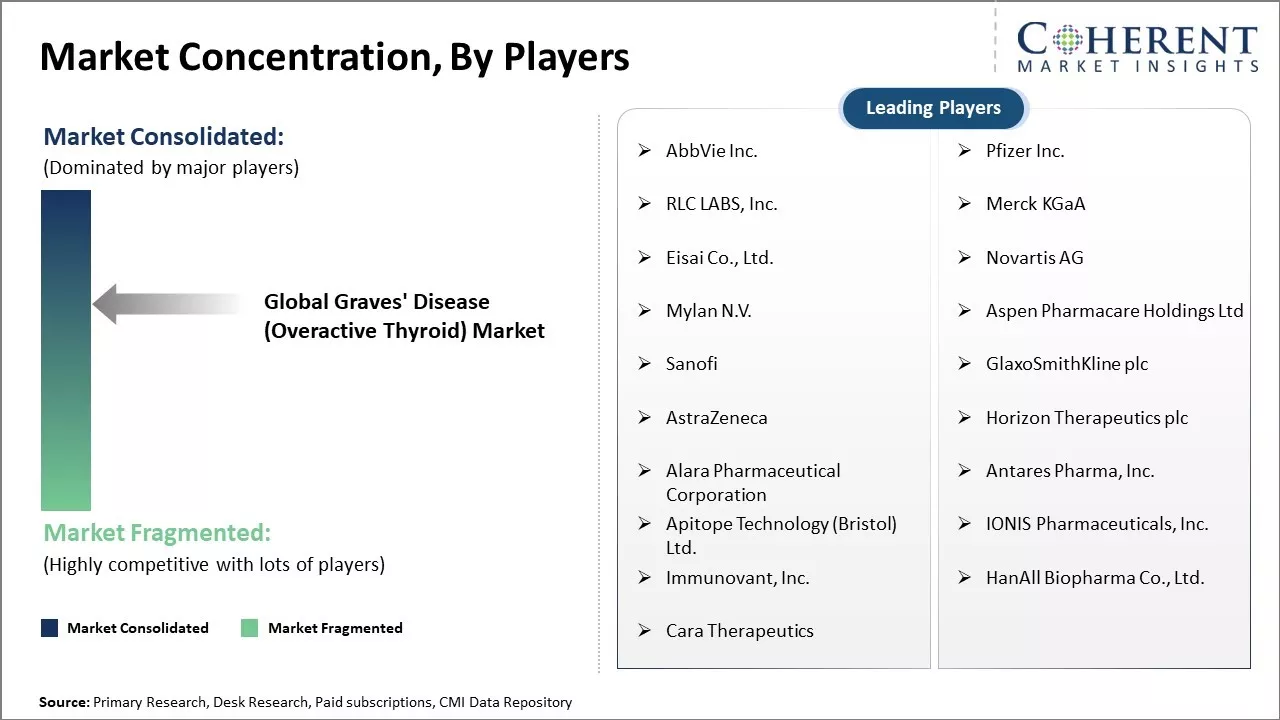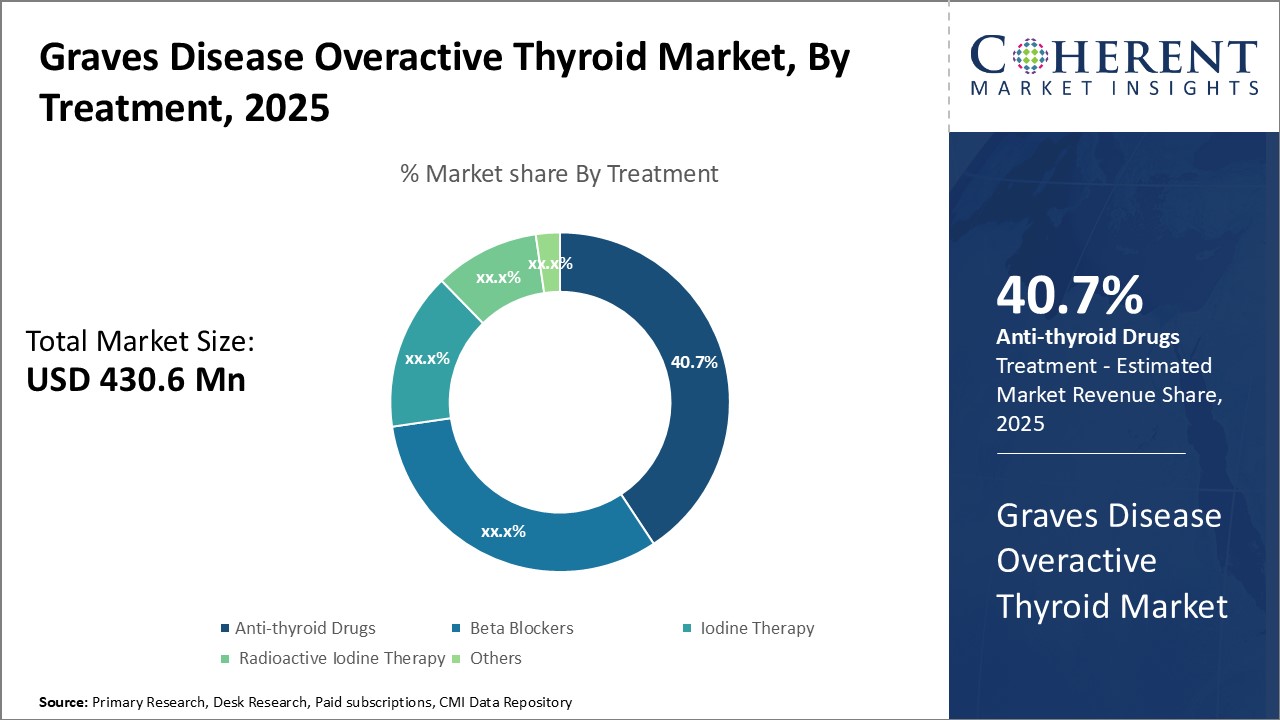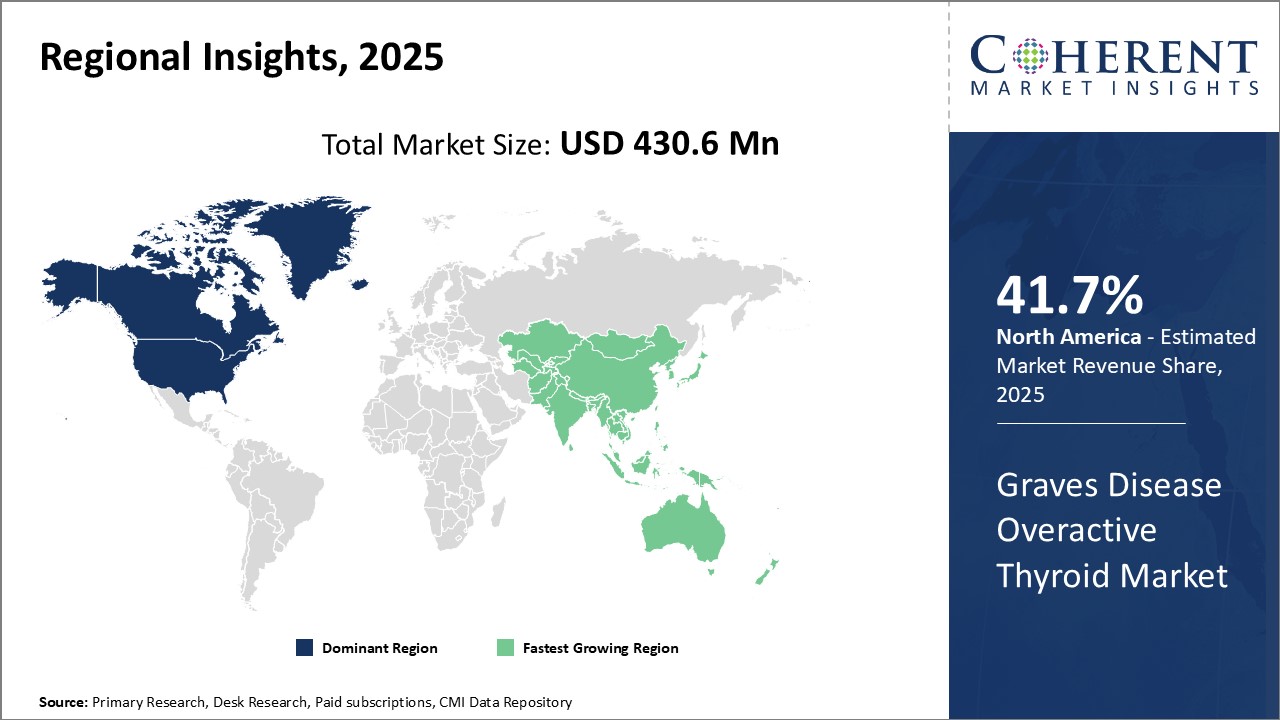Graves Disease Overactive Thyroid Market Size and Trends
Global graves' disease (overactive thyroid) market is estimated to be valued at USD 430.6 Mn in 2025 and is expected to reach USD 606.4 Mn by 2032, exhibiting a compound annual growth rate (CAGR) of 5.0% from 2025 to 2032.

Discover market dynamics shaping the industry: Download Free Sample
Graves' disease, an autoimmune disorder causing hyperthyroidism, is one of the leading causes of too much thyroid hormone in the blood. Graves' disease (overactive thyroid) market is expected to witness steady growth due to rising incidence rates of graves' disease worldwide. Increasing adoption of innovative therapies and pipeline drugs for improved treatment outcomes of graves' disease can also drive the market growth. However, social consequences of the pandemic and economic uncertainties can negatively impact the market growth. Increased awareness and improved diagnosis of this disease can drive the market growth over the forecast period. For instance, in April 2020, according to the article published on 'What is the Prevalence of Graves' Disease in the US?', Graves' disease stands as the leading cause of hyperthyroidism in the U.S., with an estimated incidence rate of about 30 cases per 100,000 individuals annually. This high prevalence places a significant burden on healthcare systems, thus, boosting demand for therapeutic and diagnostic solutions.
Risk Factors Contributing to Graves' Disease Prevalence
Rising prevalence of Graves' disease can be attributed to various lifestyle and genetic risk factors that make individuals more susceptible to developing the condition. Studies have shown that Graves' disease is more common in women, with the female to male ratio being approximately 7.5:1. Fluctuating estrogen levels during periods of reproductive life like puberty, pregnancy and menopause can influence the autoimmune process. As more women are delaying childbearing and pregnancy to later ages due to social and career reasons, it increases their exposure to these hormonal changes. Family history of other autoimmune diseases like thyroiditis, vitiligo and diabetes also increases the risk of the disease. Environmental pollutants like cigarettes, air pollutants and high nitrate levels in food and water have been implicated in disturbing the autoimmune balance in genetically predisposed individuals. Increasingly fast-paced lifestyle with prolonged periods of mental and physical stress weakens the body's natural defense mechanisms. Moreover, modern industrial food production relies heavily on excessive use of fertilizers and preservatives which leads to higher consumption of these risk factors via various food sources on a daily basis. All of these lifestyle and genetic determinants aggregately contribute to rising incidence of Graves' disease.
Market Concentration and Competitive Landscape

Get actionable strategies to beat competition: Download Free Sample
Growing Awareness Propelling Earlier Diagnosis
Increased global focus on thyroid health in recent years has boosted awareness and detection rates for Graves' disease. Nowadays, people are more knowledgeable about symptoms of an overactive thyroid like unintended weight loss, palpitations, eye bulging, and others, thus, these people seek medical advice for evaluation. Moreover, diagnostic advancements have made it possible for doctors to identify thyroid abnormalities much earlier through sensitive blood tests and thyroid scans. This results in more Graves' disease cases being picked up at mild and moderate stages rather than at later severe phases. Growing number of specialized endocrinology centers and availability of expert doctors in both rural and urban areas have further strengthened healthcare access and diagnostic infrastructure. Population-wide screening programs for early thyroid issues have also been launched in several countries. Integrated with hyperlocal health outreach initiatives, these measures enables timely diagnosis of Graves' disease in communities.
Key Takeaways from Analyst:
Global graves' disease (overactive thyroid) market is expected to witness significant growth over the forecast period owing to rising incidence rates of thyroid disorders. Increasing environmental pollution and changing lifestyle habits can also drive the market growth. Moreover, growing awareness about early diagnosis and treatment of Graves' disease can boost the market expansion.
The costly management and treatment procedures of the disease can act as a barrier, especially in price-sensitive developing nations. Availability of alternative treatment options for hyperthyroidism can also pose challenge for the market growth.
Asia Pacific region represents one of the most lucrative markets for Graves' disease due to the large patient pool and rising healthcare expenditure in countries like China and India. North America holds the second largest share and will continue to generate high demand in the near future.
Among treatment, anti-thyroid drugs segment is expected to dominate the market due to proven efficacy and relatively affordable cost. Radioiodine therapy is also gaining popularity due to advantages of long-term control and cure. Meanwhile, surgery provides relief to patients unresponsive to drug therapies.
Market Challenges: Stringent regulations
Stringent regulations imposed by various government organizations around the world can hamper the market growth. Graves' disease treatment involves the use of radioactive iodine (RAI), which is a regulated practice. Obtaining proper licenses and approvals to handle and administer RAI is time consuming process. This increases the treatment costs and delays patient care. For example, in the European Union, approval for use of ionizing radiation including RAI can take up to 18 months as per the regulations laid down by European Commission in their Directive 2013/59/Euratom. Such long approval times not only discourages new market players from entering this space but also restricts the expansion plans of existing players.
Market Opportunities: Increasing adoption of nitinol-based medical products worldwide
Emerging markets in developing countries can offer market growth opportunity. Graves' disease, also known as hyperthyroidism, is an autoimmune disorder where the thyroid gland becomes overactive and enlarges. According to the World Bank, emerging economies are expected to witness significant increase in their average incomes over the next few years, enhancing access to healthcare for many people. As economic conditions improve across Africa, Asia, Latin America and the Caribbean, more patients will be able to seek proper diagnosis and treatment for this condition. Rising awareness about disease coupled with increased healthcare expenditures can drive the market growth. Several non-profit organizations like the World Health Organization and national government programs are educating people about thyroid disorders in rural areas through awareness drives and mobile health clinics. This helps to identify previously undiagnosed cases. According to the data published by WHO in 2021, many developing nations have also increased national budgetary allocations for public healthcare systems. This will boost infrastructure and make resources for Graves' disease management more widely available.

Discover high revenue pocket segments and roadmap to it: Download Free Sample
Insights By Treatment- Ease of administration drives anti-thyroid drugs segment growth
In terms of treatment, anti-thyroid drugs segment is estimated to contribute the highest market share of 40.2 % in 2025, owing to ease of administration through oral route. Anti-thyroid drugs are usually the first line of treatment for Graves' disease as these are convenient to take and does not require hospital visits. These act by blocking the production of thyroid hormones and reducing the activity of the overactive thyroid gland. Some of the commonly used anti-thyroid drugs are Propylthiouracil (PTU) and Methimazole. These drugs are available over the counter and can be taken regularly at home, thus, making compliance less of an issue. The oral administration of pills also ensures uniform exposure of drugs in the body as compared to other routes. This factors greatly influences the patient preference and physician prescription towards anti-thyroid drugs segment.
Insights By Route of Administration - Convenience of self-administration boosts oral route segment
In terms of route of administration, oral segment is estimated to contribute the highest market share of 60.12 % in 2024 as it is the most convenient method for self-administration. The oral route is non-invasive and painless in nature. Medications administered through the oral route, which mainly includes anti-thyroid drugs, does not require presence of healthcare professionals. This enables patients to self-administer treatment flexibly, according to prescribed dosage instructions at any location. The oral medications also have long shelf life and does not require special storage conditions. Due to the ease of use without medical supervision, oral route witnesses high patient adherence for long-term medication use in Graves' disease management. This makes it the preferred administration method over parenteral route.
Insights By Distribution Channel- Accessibility and availability drives hospital pharmacies segment
In terms of distribution channel, hospital pharmacies segment is estimated to contribute the highest market share of 40.21 % in 2025, owing to high accessibility and medicine availability. Hospital pharmacies are an integral part of medical facilities and patients can directly procure prescription-based drugs from these in-house pharmacies. This segment has emerged as the main distribution channel as hospital visits remain high for Graves' disease patients, especially during initial diagnosis and treatment stage that may require radioactive iodine therapy or surgery. Moreover, hospital pharmacies stock a wider range of drugs including specialty medications for thyroid disorders as compared other channels. These also have provision for counselling, storage as well as delivery of temperature sensitive drugs. This ensures convenient access to therapies within the hospital premises and associated medical supervision, driving its dominance in the distribution landscape.
Regional Insights

Need a Different Region or Segment? Download Free Sample
North America dominates the global graves' disease (overactive thyroid) market with estimated market share of 41.7% in 2025 The region has a strong presence of leading pharmaceutical companies focusing on research and development for novel graves’ disease treatment options. With growing prevalence of thyroid disorders and increasing healthcare expenditure in the U.S. and Canada, there has been huge demand for Graves’ disease medications. The region also has an well-developed regulatory framework and favorable reimbursement scenario supporting new product approvals. Thus, North American countries are quick to adopt novel therapeutic approaches and recently FDA-approved drugs compared to other regions.
Asia Pacific market is poised to emerge as the fastest growing regional market in the near future. Rising healthcare awareness coupled with improving access to healthcare facilities especially in developing countries like India and China can offer opportunities for market players. These nations have a large patient pool suffering from thyroid disorders owing to genetic risks and evolving lifestyle changes. Increasing local manufacturing of generic drugs has made Graves’ disease medications more affordable for patients in Asia Pacific. International players are also expanding their local production plants to cater to demand and leverage low-cost manufacturing advantages.
Market Report Scope
Graves’ Disease (Overactive Thyroid) Market Report Coverage
| Report Coverage | Details | ||
|---|---|---|---|
| Base Year: | 2024 | Market Size in 2025: | USD 430.6 Mn |
| Historical Data for: | 2020 To 2024 | Forecast Period: | 2025 To 2032 |
| Forecast Period 2025 to 2032 CAGR: | 5.0% | 2032 Value Projection: | USD 606.4 Mn |
| Geographies covered: |
|
||
| Segments covered: |
|
||
| Companies covered: |
AbbVie Inc., Pfizer Inc., RLC LABS, Inc., Merck KGaA, Eisai Co., Ltd., Novartis AG, Mylan N.V., Aspen Pharmacare Holdings Ltd, Sanofi, GlaxoSmithKline plc, AstraZeneca, Horizon Therapeutics plc, Alara Pharmaceutical Corporation, Antares Pharma, Inc., Apitope Technology (Bristol) Ltd., IONIS Pharmaceuticals, Inc., Immunovant, Inc., HanAll Biopharma Co., Ltd., Cara Therapeutics |
||
| Growth Drivers: |
|
||
| Restraints & Challenges: |
|
||
Uncover macros and micros vetted on 75+ parameters: Get instant access to report
Graves Disease Overactive Thyroid Industry News
- In June 2022, Sling Therapeutics, Inc., a biopharmaceutical company, led by TPG's The Rise Fund, launched a Series A funding round that raised USD 35 million. These funds will be used to support a Phase 2b clinical trial that will evaluate the company's experimental medication, linsitinib, for the treatment of thyroid eye disease (TED). TED is primarily reported in women and is most usually associated with hyperthyroidism resulting from Graves' illness.
- In May 2022, Mindray, a medical instrumentation manufacturer, launched the TRAb assay designed for diagnosing and managing Graves' disease. Thyrotropin receptor antibody (TRAb), recognized as the pathogenic antibody in Graves' disease, serves as a pivotal serum biomarker aiding in diagnosis.
- In January 2021, The U.S. FDA granted approval for the first drug to treat Thyroid Eye Disease (TED), an autoimmune inflammatory condition primarily affecting individuals with Graves' Disease and hyperthyroidism. Around 25-50% of Graves' patients experience TED, with cases often appearing either in the 40s or 60s. Various environmental factors, particularly smoking, are linked to an elevated TED risk.
*Definition: The market for graves' disease (overactive thyroid) t, characterized by an overactive thyroid, encompasses pharmaceuticals and medical devices utilized in both diagnosis and treatment. Key treatment modalities include antithyroid medications, radioactive iodine therapy, and surgical interventions. This market caters to both branded and generic drugs aimed at managing the long-term effects of hyperthyroidism induced by Graves’ disease. Diagnostic instruments like thyroid function tests and thyroid scans play a crucial role in identifying this autoimmune disorder.
Market Segmentation
- Treatment Insights (Revenue, USD Mn, 2020 - 2032)
- Anti-thyroid Drugs
- Beta Blockers
- Iodine Therapy
- Radioactive Iodine Therapy
- Others
- Route of Administration Insights (Revenue, USD Mn, 2020 - 2032)
- Oral
- Parenteral
- Others
- Distribution Channel Insights (Revenue, USD Mn, 2020 - 2032)
- Hospital Pharmacies
- Retail Pharmacies
- Online Pharmacies
- Regional Insights (Revenue, USD Mn, 2020 - 2032)
- North America
- U.S.
- Canada
- Latin America
- Brazil
- Argentina
- Mexico
- Rest of Latin America
- Europe
- Germany
- U.K.
- Spain
- France
- Italy
- Russia
- Rest of Europe
- Asia Pacific
- China
- India
- Japan
- Australia
- South Korea
- ASEAN
- Rest of Asia Pacific
- Middle East
- GCC Countries
- Israel
- Rest of Middle East
- Africa
- South Africa
- North Africa
- Central Africa
- North America
- Key Players Insights
- AbbVie Inc.
- Pfizer Inc.
- RLC LABS, Inc.
- Merck KGaA
- Eisai Co., Ltd.
- Novartis AG
- Mylan N.V.
- Aspen Pharmacare Holdings Ltd
- Sanofi
- GlaxoSmithKline plc
- AstraZeneca
- Horizon Therapeutics plc
- Alara Pharmaceutical Corporation
- Antares Pharma, Inc.
- Apitope Technology (Bristol) Ltd.
- IONIS Pharmaceuticals, Inc.
- Immunovant, Inc.
- HanAll Biopharma Co., Ltd.
- Cara Therapeutics
Share
Share
About Author
Ghanshyam Shrivastava - With over 20 years of experience in the management consulting and research, Ghanshyam Shrivastava serves as a Principal Consultant, bringing extensive expertise in biologics and biosimilars. His primary expertise lies in areas such as market entry and expansion strategy, competitive intelligence, and strategic transformation across diversified portfolio of various drugs used for different therapeutic category and APIs. He excels at identifying key challenges faced by clients and providing robust solutions to enhance their strategic decision-making capabilities. His comprehensive understanding of the market ensures valuable contributions to research reports and business decisions.
Ghanshyam is a sought-after speaker at industry conferences and contributes to various publications on pharma industry.
Missing comfort of reading report in your local language? Find your preferred language :
Transform your Strategy with Exclusive Trending Reports :
Frequently Asked Questions
EXISTING CLIENTELE
Joining thousands of companies around the world committed to making the Excellent Business Solutions.
View All Our Clients
